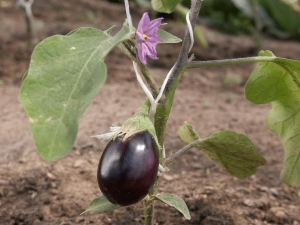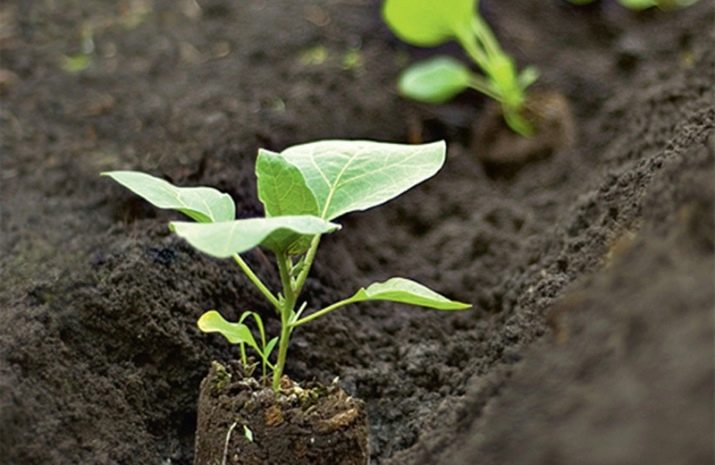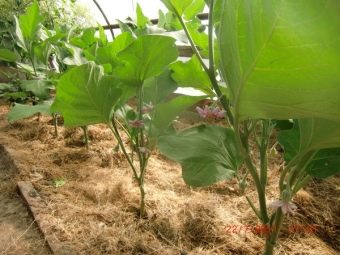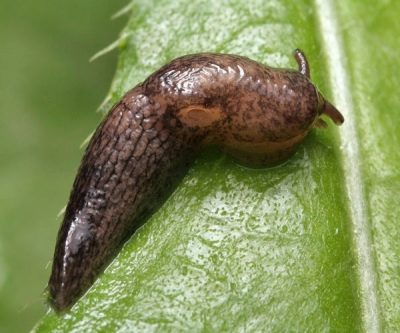How to plant eggplant seedlings in open ground or greenhouse?

Eggplant is one of our favorite vegetables.It belongs to the nightshade family, like tomato, paprika, and potatoes. But he has many difficulties in growing and care, he is very capricious in content.
Special features
Of all the solanaceae growing in our plots and gardens, eggplant is the most thermophilic. This is a culture with a long vegetative period of development. Depending on the variety, its growing season is from 80 to 140 days. Therefore, in most areas of our country, the cultivation of "blue" is possible only through seedlings.
For the cultivation of this vegetable seedlings need to meet some of the conditions.
We prepare the soil
The soil can be purchased ready, special for eggplants, with neutral acidity. But you can also cook it at home: take one part of lowland peat, two parts of humus, half of the compacted sawdust. It must be remembered that eggplant seedlings do not tolerate high acidity, therefore it is impossible to use fresh sawdust and organic matter for these purposes. If the ground is not sufficiently loose and airy, add large river sand. The resulting composition is better to disinfect. This can be done in several ways:
- take out the prepared soil for several days in the cold;
- ignite in the oven;
- steam over boiling water;
- shed hot solution of saturated color potassium permanganate.
Soil disinfection is necessary to prevent the spread of bacterial and viral infections. And we also get rid of the larvae of various pests.
After preparing the soil you need to prepare the seeds. To disinfect future seedlings from diseases and parasites, you need to soak the seeds in a weak solution of potassium permanganate for half an hour, after they are folded into a bag of gauze or bandage. After that, wash the seeds and place in a solution of a growth stimulator for several hours.
To further increase the time of emergence, the seeds are germinated. To do this, spread a damp cloth on a platter, put decontaminated seeds on it, cover it with a cloth again and put a saucer in a warm dark place for a couple of days. As soon as the seeds hatch, they can be planted.
Eggplants are conveniently grown in special containers for seedlings or in disposable cups. There is poured already moistened soil, it should be airy, not compressed. In this case, the weak roots of the plant will easily germinate. Above the seeds are laid out one by one in each cup and press a little with a toothpick. Then moisten the earth mixture from the spray. The soil should be wet, but not wet.
Cassettes or cups on top covered with film or glass, put on a pallet, which is determined in a warm dark place. Ideal location for seed germination - next to the battery.
Separately, it should be noted that eggplants, being a southern plant, sprout only at a certain temperature. In the first few days, the temperature for germination of seeds is + 25 ... 28 degrees. Daily temperature fluctuations from + 15 ... 16 degrees at night to + 25 ... 27 in the afternoon are welcomed. It hardens the young plants and stimulates the tab buds. If the room is below plus 13, the seedlings will not develop.
Due to the fact that in the middle zone conditions, these plants are planted with seeds in early or mid-February, and the light day is still short, the seedlings must be highlighted. You can do this with incandescent bulbs or LED lights. But it is still better to use specialized fitolamps. They have the necessary spectrum for plants.
In order to avoid the appearance of a black leg, watering young plants is better in the pan, this method also stimulates rooting. Excess water needs to be cleaned so that the roots do not rot. Water the seedlings with warm, settled water.
Before planting in the ground or greenhouse, young plants need to be hardened.A couple of weeks before disembarking, seedlings are brought to a cooler room for 2-3 hours, for example, to a balcony. Every day, the period of stay in the cool increases, and then completely left there.
For the day of disembarkation, suitable seedlings look strong and healthy. This plant is 15-20 cm tall with 5-7 leaves and several buds.
How to land in the ground?
Eggplant seedlings are planted at the age of 60-70 days. At this point, seedlings are best tolerated transplant. Of course, it is necessary that during the landing there was no cold weather and recurrent frosts.
For planting eggplants in a greenhouse or open ground, it is desirable to prepare a place in advance. This must be done in accordance with the rules of crop rotation. It is not necessary to plant the "blue", if at this site the other predecessors were predecessors. Their representatives have the same pests, diseases and similar requirements for the composition of the soil, so the required minerals for eggplants are not enough. The best of their predecessors in the garden are pumpkin crops: cucumbers, zucchini, pumpkins, watermelons, melons. “Blue” after legumes also grows well: beans, peas and beans. And after cabbage and onions.
To plant eggplants, it is necessary to prepare the soil. For this purpose, humus and a tablespoon of wood ash are introduced into each landing pit. 2-3 liters of water should be poured into each well. The soil in the seedling cup is richly moistened so that it is easier to extract the young plant. Then the seedling is transferred into the hole, the ground is poured and slightly compacted. On top of the landing, you can mumble rotary manure.
A place with a bed of eggplants should be allocated on a sunny, protected from drafts area. It is advisable to prepare this part of the vegetable garden as early as autumn: first dig it up, get rid of weeds and apply the necessary fertilizers (superphosphate and urea). In the spring, you only have to remove the remaining weeds, fill the ground with rotted humus with ashes.
Planted seedlings, depending on the height of the variety according to this plan: 40 cm between plants and 50 cm between rows, if the variety is low, and 50 to 60 cm, if high.
Since eggplants are afraid of cold weather, in the conditions of open ground they are first planted under the film on metal arcs. Then, as it warms, it is left only for the night.
But if even in summer the temperature drops significantly, it is recommended to cover the plants with a film.
Planting in the greenhouse
In the conditions of the North and the middle strip, eggplants should be grown in a greenhouse. Eggplant favorite temperature - plus 25-28 degrees. But in the greenhouse of polycarbonate in the heat the temperature reaches 35-45 degrees, which can be detrimental to these plants.
When planting eggplants in the greenhouse, we prepare the soil in the same way as for planting in open space. The rest of the agrotechnology is similar.
"Blue" are very fond of systematic watering. The water temperature is best around 25 degrees. It is necessary to water the eggplants in the greenhouse in the morning, then mulch the soil and ventilate the greenhouse. In order to avoid the appearance of fungal diseases, it is necessary to ventilate the greenhouse regularly, while avoiding drafts, that is, the doors and transoms of the greenhouse are opened from one side.
In the greenhouse "blue" grow well above their counterparts from open ground. Therefore, they are advised to tie up to the pegs.
Care
Eggplant care is simple and consists of systematic watering and timely feeding, as well as removing weeds, loosening the ground and fighting parasites.
Eggplants are very picky about soil moisture, its lack affects the growth and development of the crop.
During the growing season, eggplants need to be fed several times.
- For the first time, fertilizing should be done two weeks after planting, when the plant is well rooted. Feed up a solution of rotted manure or bird droppings with the addition of 1 tbsp. Spoons nitrofoski.
- The second dressing is made at the beginning of the formation of fruits by the same means, adding wood ash.
- The third feeding is carried out two weeks after the previous one. Like other plants, all dressings are produced on moist soil.
Diseases and pests
Eggplant is at risk of contracting various diseases. Consider some of them.
- Root neck rot (black leg) formed by excessive watering, high planting density and low temperature. The causative agent of this disease is a fungus that causes damage to the root collar. You can prevent this disease by observing the irrigation regime.
- Black spot all parts of the plant are affected. On the leaves first appear black spots with a yellow border, which gradually increase in size. To protect the use of funds "Fitolavin" and "Barrier".
- Mosaic the leaves of these vegetables are mainly infected when picking and growing seedlings. This virus is often infected with seed and earth. Therefore, it is very important to carry out the disinfection of seeds and soil. With this disease, a mosaic pattern appears on the leaves, and yellow spots appear on the fruit. From such plants should get rid of. The rest are processed by "Phytosporin" and "Zircon".
- Late blight susceptible to all the vegetables of the melon family One of the main methods of preventing disease is to observe the rules of crop rotation: one should not plant eggplants after planting tomatoes, peppers and potatoes on this site. Late blight is a fungal disease that appears, like the black leg, with excessive soil moisture. The disease is manifested by the appearance of brown spots on the upper side of the leaves, and the bottom - white bloom. Rot appears on the fruit. In this disease landing are treated with copper-containing drugs, "Fitosporin" and "Zircon".
- Gray rot develops at high humidity. This is another of the fungal diseases. A distinctive feature - the presence of watery spots on the leaves, which are then covered with a gray bloom, turn yellow and fall off. It starts from the basal area, rises to the leaves and fruits, which also rot. The treatment is made by fungicides.
- White rot It is also caused by excessive humidity and low temperatures during the period of planting of seedlings in open ground, or when the seedlings are frozen. Brown ring-shaped stripes appear on the stems, the shoots gradually dry up, the leaves curl, and the plant drops them. The affected parts are removed and the remaining parts are sprinkled with ashes.
- Mealy dew - This is a fungal disease that is more common in greenhouse conditions. White scurf appears on the lower leaves, then rises higher and is transferred to the whole plant. Eggplants stand as though sprinkled with flour. Powdery mildew uses the drugs "Fitosporin", "Gaupsin" and "Trikhodermin."
- Verticillosis or wilt - Eggplant mushroom infection, which is notable for yellowing and wilting of the leaves. First, lower leaves are affected, then the plant fades away completely. Patients are destroyed, the rest are treated with bromide.
In addition to various diseases, eggplant susceptible to pest invasion.
- Slug mainly interested in young landing. For their repellences use a mix of ash, lime and tobacco dust. Loosen the earth and sprinkle the aisles with this mixture.
- White fly feeds on the sap of the plant, like other parasites. At the same time, it releases certain substances conducive to the appearance of fungal diseases. It settles on the inside of the leaves. To get rid of the whitefly, use the preparations "Fitoverm", "Aktellik" and "Aktara".
- Appearance on vegetables spider mite due to dryness and fever. Usually they are affected plants grown in greenhouses. The best prevention of its appearance is an increase in humidity in the greenhouse. For the destruction of the tick are the drugs "Fitoverm", "Aktellik", "Fufanon".
- First appearance signal aphids - this is twisting and falling leaves.Aphid lives in colonies on the back of the leaf and multiplies rapidly. Eating the sap of the plant, causes him great damage. Therefore, it is necessary to get rid of the pest in a short time. The means for fighting with aphids are Strela, Tanrek, Biotlin, Fitoverm.
- Colorado beetle harms not only the potato, he seeks to feast on the leaves and "blue". Its larvae are especially dangerous, they destroy young leaves and ovaries of plants. From the Colorado potato beetle there are drugs "Karate", "Prestige", "Sonnet".
Tips and tricks
As follows from the above, eggplant is a demanding vegetable, rather difficult to grow. In order to enjoy its exquisite and savory taste, it is necessary to observe certain requirements when growing it:
- presowing seed treatment;
- soil disinfection;
- crop rotation;
- correct agricultural practices;
- moisture control in the greenhouse;
- regular inspection of plants for diseases and pests;
- destruction of diseased plants;
- timely application of fertilizers and fertilizers.
It remains only to apply this knowledge in practice and enjoy the excellent harvest of “blue ones” on your site.
For tips on how to plant eggplant seedlings in a greenhouse or ground, see the following video.














































